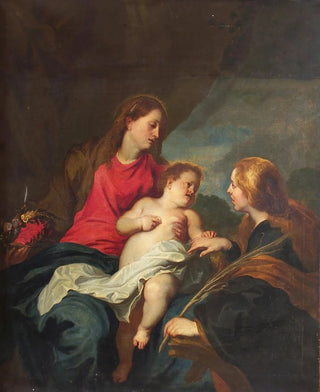Art print | The Mystic Marriage of Saint Catherine of Alexandria - Antoine van Dyck


View from behind

Frame (optional)
Introduction captivante
The mystical marriage of Saint Catherine of Alexandria, an iconic work by Antoine van Dyck, stands as a true masterpiece of Baroque painting. This captivating scene evokes the spiritual depth and emotional intensity that characterize Van Dyck's art. By immersing oneself in this representation, the viewer is immediately transported into a universe where faith, beauty, and symbolism intertwine harmoniously. The composition, rich in colors and details, invites meditative contemplation, revealing the subtleties of the relationship between the divine and the human. Through this art print, the work continues to fascinate and provoke thought, testament to the timeless power of art.
Style and uniqueness of the work
The mystical marriage of Saint Catherine of Alexandria is distinguished by its sumptuous style and technical mastery. Van Dyck, a true virtuoso, manages to create an atmosphere that is both serene and emotionally charged. The sumptuous drapery of the garments, the subtle play of light and shadow, as well as the delicate expressions on the faces, demonstrate great skill. The chosen palette, oscillating between warm tones and cooler shades, gives the art print depth and visual richness that captivate the eye. Every element of the composition, from the gestures of the characters to the arrangement of objects, is carefully thought out to reinforce the spiritual message conveyed by the work. This stylistic singularity makes this art print a perfect example of Baroque art, where visual storytelling becomes a powerful means of expression.
The artist and his influence
Antoine van Dyck, a pupil of Rubens, established himself as one of the great masters of his time, leaving an indelible mark on the art world. His journey, marked by stays in Italy and England, enriched his style and artistic approach. Van Dyck skillfully combined Italian and Flemish influences to create a unique aesthetic, characterized by refined elegance and particular attention to detail. His impact on portrait painting and the depiction of nobility

Matte finish

View from behind

Frame (optional)
Introduction captivante
The mystical marriage of Saint Catherine of Alexandria, an iconic work by Antoine van Dyck, stands as a true masterpiece of Baroque painting. This captivating scene evokes the spiritual depth and emotional intensity that characterize Van Dyck's art. By immersing oneself in this representation, the viewer is immediately transported into a universe where faith, beauty, and symbolism intertwine harmoniously. The composition, rich in colors and details, invites meditative contemplation, revealing the subtleties of the relationship between the divine and the human. Through this art print, the work continues to fascinate and provoke thought, testament to the timeless power of art.
Style and uniqueness of the work
The mystical marriage of Saint Catherine of Alexandria is distinguished by its sumptuous style and technical mastery. Van Dyck, a true virtuoso, manages to create an atmosphere that is both serene and emotionally charged. The sumptuous drapery of the garments, the subtle play of light and shadow, as well as the delicate expressions on the faces, demonstrate great skill. The chosen palette, oscillating between warm tones and cooler shades, gives the art print depth and visual richness that captivate the eye. Every element of the composition, from the gestures of the characters to the arrangement of objects, is carefully thought out to reinforce the spiritual message conveyed by the work. This stylistic singularity makes this art print a perfect example of Baroque art, where visual storytelling becomes a powerful means of expression.
The artist and his influence
Antoine van Dyck, a pupil of Rubens, established himself as one of the great masters of his time, leaving an indelible mark on the art world. His journey, marked by stays in Italy and England, enriched his style and artistic approach. Van Dyck skillfully combined Italian and Flemish influences to create a unique aesthetic, characterized by refined elegance and particular attention to detail. His impact on portrait painting and the depiction of nobility






